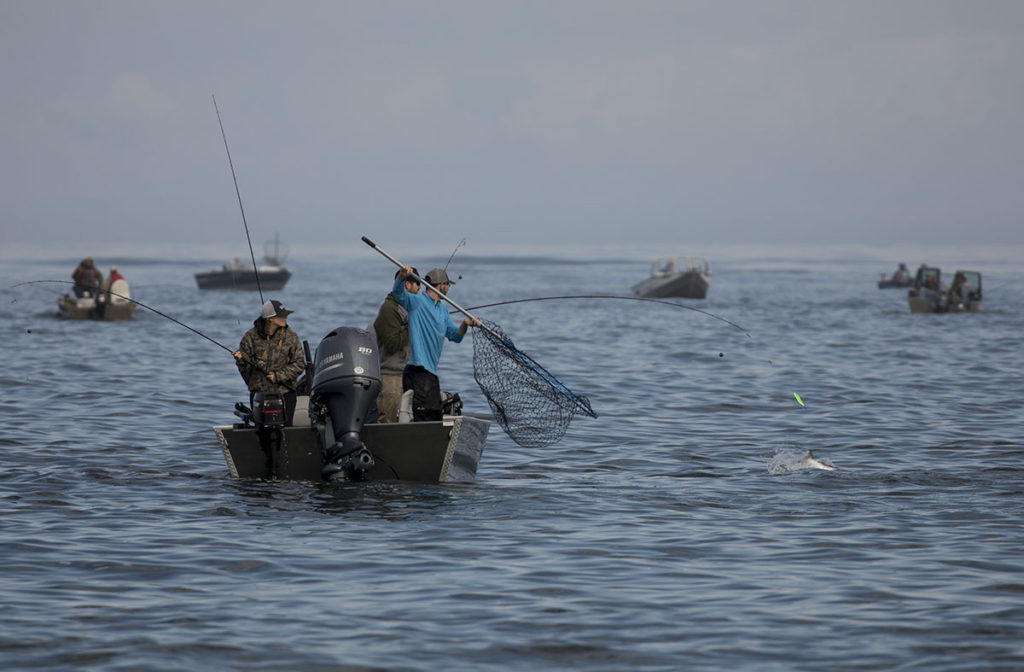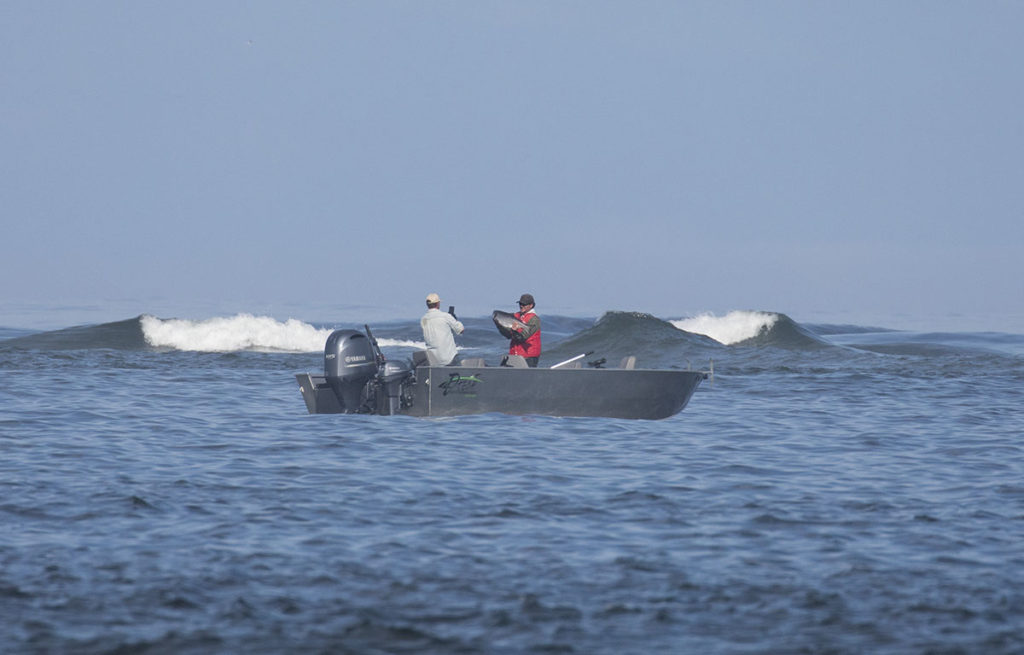
By QUINTON SMITH/YachatsNews
After two years of higher catch limits, Oregon’s fishery managers are cutting back on Chinook salmon harvests in bays and rivers along the central coast starting next month because of deteriorating ocean conditions.
The only bright spot for central coast streams is that coho salmon – which are listed as endangered by the federal government – are doing well enough to again allow limited fishing in many areas. The coho fishery is considered tentative until final approval from the National Marine Fisheries Service, expected later this month.
For most mid-coast streams, the season limit for Chinook salmon is 10 fish this summer and fall – half of what it was the past two years. But, as John Spangler, regional biologist for the Oregon Department of Fish & Wildlife points out “not that many people catch 20 wild Chinook salmon in a season.”

Before setting those limits, ODFW asked for public comments – 700 people or groups responded — on whether it should restrict fishing even more. It settled on the higher of the two proposals – a 5-10 Chinook season limit in most coastal streams – rather than a limit of 2-5 fish. The higher limits were still half of those in 2022.
“We know these fisheries are important to coastal communities and we want to ensure anglers can continue to harvest fish over the long run,” ODFW deputy fish division administrator Shaun Clements said in a statement announcing the limits. “We have demonstrated over many decades that harvest can be sustainable if it is scaled based on health of runs to ensure enough fish make it to spawning to produce the next generation.
“Unfortunately, we’re seeing warning signs region wide, with many fisheries closing from California to Alaska,” he said. “We’re also seeing concerning signs in several basins that have been at or below critical abundance for several years, increasing freshwater harvest rates, and more uncertainty in the forecasts because of the changing climate and ocean conditions.”
Except for some hatchery salmon that return to the Salmon River in north Lincoln County, the fall Chinook that enter coastal bays and streams are wild fish that depend on a natural spawning cycle before leaving rivers each spring to spend 3-5 years in the ocean.
And that’s where the problem is currently. Ocean conditions are also on a downturn again.
The National Oceanic and Atmospheric Administration is predicting an El Nino in the Pacific Ocean this summer which brings warmer waters, less upwelling of nutrients that salmon rely on and overall worse conditions for salmon.
“There has been a brief period of generally good ocean conditions in 2021 and to a lesser extent in 2022, that benefited some runs of salmon,” Clements said in an agency webinar last month. “But the developing El Nino will bring a return of poor conditions and it may be some time before we see several years of really good Chinook salmon returns in a row across the coast, as we used to prior to 2015.”
Spangler said the ocean environment for salmon is just not as productive as it was the past two years.
“Until we can understand what’s going on it’s probably best to take a conservative approach” to bag limits, he said.
For the entire coast, there are some mixed issues.
The Siuslaw River is again open for limited fall Chinook fishing after being closed for two years because of poor returns. The Coquille River is closed entirely because of a collapse in salmon returns due to striped bass predation on smolts.
While catch limits are loosened a bit in the Tillamook and Nestucca river basins, Clements said there has been a continued steep decline in salmon returns in those systems over the past 40 years and “a big decline since 2014 connected to ocean warming.”

Fishing details
Alsea River, Alsea Bay and Drift Creek: Aug. 1 to Dec. 31 — Daily adult wild Chinook salmon bag limit is two fish per person and no more than 10 for the season. The Chinook limit in 2021 and 2022 was two daily and 20 for the season. The forecast return of Chinook is 7,800 fish, 600 less than last year. Proposed wild coho: one per day and one for the season, Sept. 15-Oct. 15;
Yachats River: Aug. 1 to Dec. 31: One adult wild Chinook salmon per day and five for the season, the same as 2022. No coho retention;
Yaquina River and Big Elk Creek: Aug. 1 to Dec. 31 — Two adult wild Chinook salmon per day and 10 for the season. The forecast return of Chinook is 8,780 fish, 2,600 more than last year. Proposed wild coho: one per day and one for the season, Sept. 15-Oct. 13;
Siletz River and Drift Creek: Aug. 1 to Dec. 31 — Two adult wild Chinook salmon per day and 10 for the season. In 2021 and 2022 it was two and 20. The forecast return of Chinook is 8,750, 2,500 less than last year. Proposed wild coho: one per day and one for the season, Sept. 15-Oct. 31;
Salmon River: Aug. 1 to Dec. 31 — Two adult wild Chinook salmon per day and 10 for the season. The forecast return of Chinook is 1,600 fish, 200 less than last year. There is no coho fishery.
Beaver Creek: No Chinook fishery but for the second straight year the stream is open to coho fishing from Nov. 1-30 with a daily and season limit of one fish.
Nestucca River, Nestucca Bay, Little Nestucca River, and Three Rivers: Aug. 1 to Nov. 30 — Daily adult wild Chinook salmon bag limit is one fish and five for the season. The forecast return of Chinook is 5,500 fish, 800 more than last year. Proposed wild coho: One per day and two for the season, Sept. 9 to Oct. 18.
Siuslaw River and Sweet Creek: Aug. 1 to Dec. 31 — One adult wild Chinook salmon per day and two for the season. The Siuslaw was closed in 2021 and 2022. The forecast return of Chinook is 6,975 fish, 1,100 more than last year.
Tillamook Bay river systems: Aug. 1 to Nov. 30 — One adult wild Chinook salmon per day and two for the season. The Tillamook system was closed to catching wild Chinook in 2022. The forecast return of Chinook is 3,500 fish, 200 less than last year. Proposed wild coho: One per day and two for the season, Sept. 9 to Oct. 18.
Nehalem River and bay and North Fork Nehalem River: July 1 to Nov. 30 — Daily adult wild Chinook salmon bag limit is one fish and five for the season. Of those five, only one may be retained prior to Sept. 16. The forecast return of Chinook is 7,975 fish, 3,000 more than last year. Proposed wild coho: One per day and two for the season, Sept. 9 to Oct. 18.



